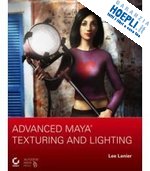
Questo prodotto usufruisce delle SPEDIZIONI GRATIS
selezionando l'opzione Corriere Veloce in fase di ordine.
Pagabile anche con Carta della cultura giovani e del merito, 18App Bonus Cultura e Carta del Docente
The art of texturing and lighting is a crucial aspect of any movie, game, or other animation project. Now you can learn the secrets of professional animators, mine powerful and often hidden features in Maya, and achieve amazing results with the detailed information you'll find in Advanced Maya Texturing and Lighting.
Written by an industry veteran whose texturing and lighting has been featured in such films as Mortal Kombat, Antz, Shrek, and many others, this in–depth book focuses on advanced techniques used in real–world production environments. You'll find out how to add complexity to your work with custom shaders, high–level texture mapping, a full understanding of lighting concepts, and an unparalleled exploration of Maya's Hypershade window. The book takes a detailed look at rendering in Maya, including everything from batch rendering to global illumination workflow and HDRI techniques. In gorgeous full color and full of tips, techniques, and workflow ideas straight from the studio, this valuable guide doesn't just teach, it shows you how to achieve the same dazzling and rapid results as the pros.
The enclosed CD features exclusive content, including two bonus chapters, Maya scene files, custom shading networks, textures, the Maya Personal Learning Edition, and files for the practical tutorials, which were designed from an industry perspective and refined in the classroom.
Chapter 1: Applying the Correct Maya Light Type.
Selecting Light Types.
Linking Lights.
Using Light Fog and Light Glow.
Chapter Tutorial: Lighting an Interior.
Chapter 2: Creating High–Quality Shadows.
Rendering Depth Maps.
Raytracing Shadows.
Creating Effects Shadows.
Chapter Tutorial: Lighting a Flickering Fire Pit with Shadows.
Chapter 3: Applying the Correct Material and 2D Texture.
Reviewing Shading Models and Materials.
Reviewing 2D Textures.
Mastering Extra Map Options.
Stacking Textures.
Mastering the Blinn Material.
with Basic Texturing Techniques.
Chapter 4: Applying 3D Textures and Projections.
Exploring 3D Textures.
Applying Environment Textures.
2D Texture Projection Options.
Chapter Tutorial: Creating Skin with Procedural Textures.
Chapter 5: Creating Custom Connections and Color Utilities.
Mastering the Hypershade Window.
Shifting Colors.
Chapter Tutorial: Creating a Custom Paint Material.
Chapter 6: Automating a Scene with Sampler Nodes.
Employing Samplers.
Tying into Nonmaterial Nodes.
Connecting Multiple Materials in One Network.
Using the Studio Clear Coat Utility.
Chapter Tutorial: Building a Custom Cartoon Shading Network.
Chapter 7: Harnessing the Power of Math Utilities.
Math Utilities.
Using Esoteric Utilities and Scene Nodes.
with Advanced Math Utilities.
Chapter 8: Improving Textures through Custom UVs, Maps, and Sliders.
Preparing UV Texture Space.
Using the 3D Paint Tool.
PSD Support.
Bump and Displacement Mapping.
Custom Sliders.
Chapter Tutorial: Preparing the UVs of a Polygon Model.
Chapter 9: Prepping for Successful Renders.
Determining Critical Project Settings.
Mastering the Render Settings Window.
Rendering with the Command Line.
Organizing the Render.
Selecting Image Formats and Render Resolutions.
Creating Depth of Field.
Applying Motion Blur.
Step–by–Step: Splitting Up a Render.
Chapter 10: Raytracing with Maya Software and mental ray.
Raytracing with Maya Software.
Raytracing with mental ray.
Reproducing Water.
Reproducing Glass.
Chapter Tutorial: Texturing and Rendering an Ice Cube.
Chapter 11: Working with Global Illumination and Final Gather.
Understanding Global Illumination.
Applying Caustics.
Using mental ray Shaders with Global Illumination.
Using Final Gather.
Fine–Tuning mental ray Renders.
Chapter Tutorial: Creating Caustics with Final Gather.
Index.
Chapter 12 Supplemental Chapter: Understanding Lighting, Composition, and Color.
Understanding the Art of Lighting.
Using 1–Point Lighting.
Using 2–Point Lighting.
Using 3–Point Lighting.
Using Naturalistic Lighting.
Using Stylized Lighting.
Understanding Color and Composition.
Checking Color Calibration.
A Note on Color Temperature.
Applying the Golden Mean.
Rule of Thirds.
Step–by–Step: 3D Lighting Examples.
Chapter 13: Supplemental Chapter: Texturing and Lighting with Advanced Techniques.
Adding Realism with HDRI.
Rendering with HDRI and mental ray.
Using HDR Images with Global Illumination.
Using HDR Images with a Light Shader.
Normal Mapping.
Using the Surface Sampler.
Creating Displacement Maps with the Surface Sampler.
Creating Diffuse and Shaded Maps with the Surface Sampler.
Managing Renders with the Render Layer Editor.
Step–by–Step: Creating the Cover Illustration.
Supplemental Materials: Additional Texturing and Lighting Techniques.
3.1: Flat and Gouraud Shading.
3.2: Creating a Custom Wireframe Render with a Ramp Texture.
3.3: Creating a Custom Window Reflection with Ramp Textures.
5.1: Controlling a Bicep with a Clamp Utility.
5.2: Creating a Stylized Metal with the Surface Luminance Utility.
6.1: Replicating Iridescence with the Surface Sampler Utility.
6.2: Re–creating Skin Translucence.
7.1: Rotating a Tire with Multiply Divide Utilities.
7.2: Solving the Length of a Triangle s Edge with a Plus Minus Average Utility.
8.1: Rebuilding Closed and Periodic Surfaces.
9.1: Adjusting NURBS Surface Tessellation.
10.1: Recreating Turbulent Water.
11.1: Creating a Simple Global Illumination Scene.
11.2: Applying mental ray Diagnostic Tools.
1 recensioni presenti.











Il sito utilizza cookie ed altri strumenti di tracciamento che raccolgono informazioni dal dispositivo dell’utente. Oltre ai cookie tecnici ed analitici aggregati, strettamente necessari per il funzionamento di questo sito web, previo consenso dell’utente possono essere installati cookie di profilazione e marketing e cookie dei social media. Cliccando su “Accetto tutti i cookie” saranno attivate tutte le categorie di cookie. Per accettare solo deterninate categorie di cookie, cliccare invece su “Impostazioni cookie”. Chiudendo il banner o continuando a navigare saranno installati solo cookie tecnici. Per maggiori dettagli, consultare la Cookie Policy.